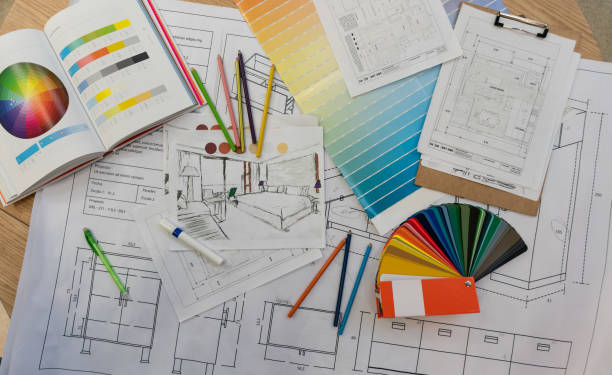As humans, we spend a considerable amount of time indoors, surrounded by walls, floors, and ceilings that define our living and working spaces. But what makes a space truly exceptional? What sets it apart from being merely functional to becoming an oasis of comfort, style, and inspiration?
The answer lies in the art and science of interior design. From lavish residences to sleek office buildings, interior designers have the power to transform empty spaces into breathtaking environments that reflect our personalities, values, and aspirations. By combining creativity, technical knowledge, and a deep understanding of human behavior, they create spaces that not only look stunning but also foster well-being, productivity, and joy.
In this blog, we’ll delve into the world of interior designing, exploring its definition, history, nature, scope, innovations, benefits, and future prospects.
Meaning & Definitions- What is Interior Designing?
Interior designing is the art and science of enhancing the interiors of buildings and structures to achieve a healthy, functional, and aesthetically pleasing environment for users. It involves careful planning, designing, and execution of various elements, such as layout, lighting, sound, color, materials, furniture, and equipment, to meet the specific needs and requirements of a space.
According to the Indian Institute of Interior Designers (IIID), interior designing meaning is stated as, “Interior design is the process of creating, modifying and coordinating the elements of interior space to satisfy the needs and requirements of the user, while simultaneously ensuring the safety, functionality, and aesthetic appeal of the space.”
History & Evolution of Interior Designing
The history of interior designing dates back to ancient civilizations, where artisans and craftsmen would create beautiful and functional pieces for royal palaces and temples. However, the modern practice of interior designing began in the late 19th century, when the first interior design schools were established in Europe and North America.
In India, the IIID was founded in 1972, marking the beginning of formal interior design education and practice in the country. Since then, interior designing has grown exponentially, with numerous colleges, universities, and professional organizations cropping up across the nation.
Nature & Features of Interior Designing
Interior designing is a multifaceted discipline that combines various elements to create a cohesive and functional space. Some of its key features include:
- Space planning: Optimizing the usage of space while ensuring comfort, accessibility, and flow.
- Material selection: Choosing appropriate materials, finishes, and textures that complement the design theme and meet functional requirements.
- Color theory: Applying color psychology and color combinations to create different moods and atmospheres within a space.
- Lighting design: Utilizing natural and artificial light sources to illuminate, highlight, and create ambiance.
- Acoustics: Managing sound levels and minimizing noise through strategic placement of materials, furniture, and fixtures.
- Furniture design: Selecting and designing furniture that serves both functional and aesthetic purposes.
- Accessorizing: Adding finishing touches through decorative items, artwork, and plants to complete the desired look and feel.
Scope of Interior Designing in India
The scope of Interior designing is vast across various industries in India, including:
- Residential design: Creating beautiful, functional living spaces for homes, apartments, and villas.
- Commercial design: Planning and designing offices, restaurants, hotels, shopping centers, and other business establishments.
- Institutional design: Developing educational institutions, hospitals, clinics, and government facilities.
- Hospitality design: Designing luxury resorts, hotels, and recreational spaces that cater to tourists and travelers.
- Industrial design: Creating efficient and safe working environments for factories, warehouses, and production units
- Public space design: Enhancing public areas like parks, museums, libraries, and community centers.
- Landscape design: Planning and designing outdoor spaces, gardens, and landscapes that complement and enhance the surrounding architecture.
Major Innovations in Interior Designing
Interior designing has witnessed numerous innovations in recent years, thanks to advancements in technology, sustainability, and changing lifestyles. Some of the most significant trends and innovations include:
- Sustainable design: Using eco-friendly materials, energy-efficient appliances, and renewable energy sources to minimize the carbon footprint of buildings.
- Smart homes: Integrating technology and automation to create homes that are comfortable, convenient, and energy-efficient.
- Green walls and vertical gardening: Incorporating plants into building design to improve air quality, reduce stress, and enhance aesthetics.
- Minimalism: Embracing simplicity and clean lines to create clutter-free, visually appealing spaces.
- Biophilic design: Incorporating natural elements and materials into building design to promote well-being and productivity.
- Adaptive reuse: Repurposing existing buildings to give them new life and reduce waste, rather than demolishing and rebuilding.
- Universal design: Creating spaces that are accessible and usable by everyone, regardless of age or ability.
- Wellness design: Incorporating features that promote physical and mental well-being, such as natural light, fresh air, and acoustic comfort.
- Resilience design: Building structures that can withstand natural disasters and climate change, and can quickly recover from damage.
Benefits of Studying Interior Designing
Pursuing a degree in interior designing offers numerous benefits, including:
- Creative expression: Interior designing allows you to express your creativity and bring your ideas to life.
- Opportunities for specialization: You can choose to specialize in a particular area of interest, such as residential design, commercial design, or sustainable design.
- Variety of job roles: Interior designers can work in a variety of settings, including architectural firms, design studios, retail stores, and construction companies.
- Good salary package: Interior designers are typically well-compensated for their work, with median salaries ranging from $50,000 to over $100,000 per year, depending on experience and location.
- Opportunities for entrepreneurship: Many interior designers choose to start their own businesses, which can provide greater autonomy and financial potential.
- Constant learning: Interior designing requires staying up-to-date with the latest trends, technologies, and materials, which can lead to continuous learning and professional growth.
- Positive impact on society: Interior designers can positively affect people’s lives by creating spaces that are functional, comfortable, and aesthetically pleasing.
Conclusion
Interior designing is a dynamic and rewarding field that offers countless opportunities for creative expression, professional growth, and positive social impact. Whether you’re interested in residential, commercial, or sustainable design, pursuing a degree in interior designing can open doors to a fulfilling and lucrative career. With the right training and dedication, you too can join the ranks of successful interior designers who are shaping the future of the built environment.
FAQs
Q: What are the subjects in interior designing course?
A: Subjects in Interior designing course typically cover a wide range of topics, including:
* Design principles and elements
* Color theory and color schemes
* Texture, material, and finishes
* Lighting design
* Space planning and layout
* Ergonomics and anthropometry
* Building codes and regulations
* Computer-aided design (CAD) and drafting
* Sustainable design and green building practices
* Historic preservation and restoration
* Cultural and contextual design considerations
Q: What are the benefits of interior designing?
A: Interior designing can offer several benefits, including:
- Improved aesthetic appeal and visual comfort
- Enhanced functionality and efficiency
- Better utilization of space and resources
- Improved safety and accessibility
- Boosted productivity and creativity
- Stress reduction and improved mental health
- Increased property value and marketability
Q: Does interior designing have scope in the future?
A: Yes, interior designing has a promising future ahead, with increasing demand for skilled professionals who can create functional, sustainable, and aesthetically pleasing spaces.
Q: What stream to choose after 10th for interior designing?
A: To pursue a career in interior designing, it is recommended to choose the arts or commerce stream after 10th standard. Subjects such as drawing, painting, mathematics, economics, and business studies can be helpful in preparing for a career in interior designing.
Q: Which group should I take in 11th for interior designing?
A: In 11th standard, it is recommended to opt for the commerce or arts stream with a focus on subjects such as math, physics, chemistry, and computer science. Additionally, taking electives such as fine arts, graphics, or design can help build a strong foundation for a career in interior designing.
Q: What is the course for interior designing?
A: There are various courses available for interior designing, ranging from diplomas to bachelor’s and master’s degrees. Some popular courses include:
* Diploma in Interior Design
* Bachelor of Arts (BA) in Interior Design
* Bachelor of Fine Arts (BFA) in Interior Design
* Master of Arts (MA) in Interior Design
* Master of Fine Arts (MFA) in Interior Design
Q: Is there any scope in interior designing in India?
A: Yes, interior designing is a rapidly growing field in India, with increasing demand for skilled professionals who can create culturally relevant and aesthetically pleasing spaces.
Q: How to make career in interior designing?
A: To make a career in interior designing, follow these steps:
- Complete a degree or diploma program in interior designing from a recognized institute.
- Gain practical experience through internships or entry-level positions in interior design firms.
- Build a portfolio of your work to showcase your skills and creativity.
- Consider obtaining certification from professional organizations such as the National Council for Interior Design Qualification (NCIDQ) or the American Society of Interior Designers (ASID).
- Stay updated with industry trends and best practices through continuing education and attending design conferences.
- Network with industry professionals and build relationships with clients and vendors.
- Consider starting your own interior design firm or collaborating with other designers on projects.



